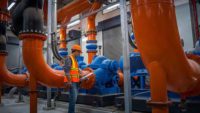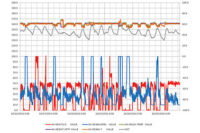Proper air and water balancing is critical to HVAC system performance. No amount of commissioning will make a system function as intended if it isn’t balanced. Design air and water flows need to be achievable in all modes of operation. Typical modes in an HVAC system include occupied, unoccupied, morning warm-up, morning cool-down, airside economizer, minimum outside air, water-side economizer, etc. This column is dedicated to the importance of testing and documenting system airflows in both the minimum outside air mode and the 100% outside air economizer mode.
Systems often experience different pressure relationships as the outside air, return air, and relief air dampers (mixing dampers) modulate from their minimum outside air positions to their 100% outside air positions. If the system cannot achieve design airflows under certain mixing damper conditions, it will result in intermittent and challenging-to-diagnose problems after occupancy.
Regardless of the heroic efforts to standardize balancing reports, commissioning professionals receive a variety of different TAB reports. In many of them it is not abundantly clear under what mixing damper conditions the documented airflows were measured. In most of them, there is no evidence that the design airflows were confirmed to be achieved in both the minimum outside air and the 100% outside air modes.
However, in general, all TAB reports include a central fan data table accompanied by tables of terminal unit airflow readings. The central fan tables vary significantly in the amount of data measured and documented. They all should (but do not necessarily) include documentation of the outside airflow in “minimum” mode. This is critical for confirming compliance with code ventilation requirements. In addition, they all should (but do not necessarily) include documentation of the supply duct static pressure (at the controlling duct pressure sensor) required to achieve design airflows at all of the terminal units.
I do not believe I have ever seen a TAB report that explicitly stated which mixing damper mode the AHU was in when the distribution system (all of the terminal units) was balanced. On more than one occasion, that has resulted in a misleadingly positive TAB report and the decision to move forward with final commissioning functional performance testing of the system.
We have commissioned AHUs where the supply fans have functioned just fine in minimum outside air mode when their return fan was pushing air into the mixing box. However, that same supply fan failed to move enough supply airflow in 100% outside air mode because the fan could not overcome the outside air intake pressure drop. Similarly, we have seen return fans that perform just fine in minimum outside air mode but are unable to develop the pressure necessary to move the design airflow through the relief air plenum in full economizer mode. In systems without return fans it is possible that the supply fan can generate sufficient static pressure in 100% outside air mode but falls short in minimum outside air mode when it is expected to draw through a return air system.
If not fully tested, documented, and resolved through the TAB process, these problems will almost certainly surface during functional performance testing. This will result in a potentially high-profile, late-stage schedule delay, troubleshooting, and retesting process. It would be much better for all involved if the TAB contractor confirmed design airflows are achievable in both minimum and 100% outside air modes during the formal TAB process.
I recommend that the TAB report indicate which mode the air handling system was in when the terminal units were balanced; document what supply duct static pressure was required; and then document that the supply duct static pressure was achievable with the mixing dampers in the opposite economizer mode. Depending on how the return fan speed is controlled, similar dual mode performance data should be recorded for the return side of the system as well.





